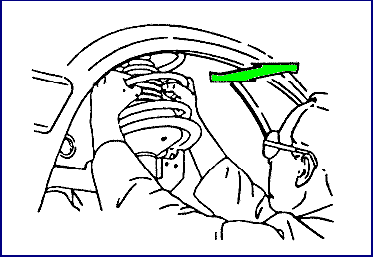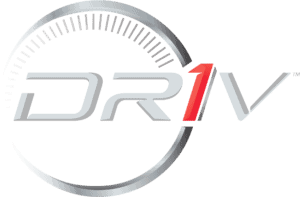INSPECTING SHOCKS AND STRUTS
Car Park Test
First check the vehicle’s mileage. When a vehicle has just 20,000 km or more, there could be some internal wear and new shocks and struts may be needed. Also, check the manufacturer’s recommended service interval in the owner’s manual.
Remember, a shock absorber provides resistance to bounce, roll or sway, brake dive, and acceleration squat. This means that the shock needs to be checked for each of these — and the best way to do this is while driving the vehicle.
Take the vehicle for a short drive around the parking lot and do a mini-test. You should still be able to tell if there’s excessive brake dive, acceleration squat, or roll or sway.
Once inside the vehicle, put on the seat belt and begin. Note any excessive vehicle squat as you accelerate: the vehicle should remain fairly stable. Next, apply the brakes and note any dive. Again, the vehicle should remain fairly stable. Try a couple of sharp turns, noting any excessive roll or sway of the vehicle.
If you noticed any excessive bounce, roll and sway, brake dive or acceleration squat this could be an indication of shock or strut control loss. This causes excessive suspension movement that could lead to handling problems and premature wear on other suspension components.
Tyres - Front and Rear
Check for any unusual wear patterns. Indication of uneven tread wear, such as cupping, can be a result of worn shocks and struts.
Check Tyres for any physical problems:
- Ply separation
- Dry rot
- Nails
Check Tyre size and construction type:
- Same size side to side
- Same brand and tread pattern
- Mix of radial-ply and bias-ply Tyres
Check the Tyre pressure on all four Tyres and adjust to the doorpost specifications or the specifications listed in the owner’s manual. The Tyre pressure established by the vehicle manufacturer will provide the best overall vehicle control and comfort.
Check the wheels for physical damage.
Upper Strut Mount Inspection
If the upper strut mount is defective, it may cause noise, steering binding, or allow the upper end of the strut to change position, affecting wheel alignment angles.
- Strut mount inspection should start with a road test checking for unusual noise, pulling, or steering binding.
- With the vehicle in the shop and the weight on the wheels, rotate the steering wheel from stop to stop while listening for noises or binding. Noise or binding could indicate a defective bearing. Also inspect the rubber portions of the strut mount for cracks or separation of the rubber from the steel. Before raising the vehicle on a hoist, note the position of the strut piston rod. Raise the vehicle and note any change in the position of the mount assembly. A slight downward movement is normal, but any side-to-side movement could indicate a defective mount.
- With the wheels off the ground, grip the coil spring as close to the upper strut mount as possible. Push in and out on the strut and spring while watching for movement of the upper end of the strut piston rod. There should be no free movement. If there is excessive movement, the upper strut mount should be replaced. If the visual inspection reveals separation of the rubber portions from the steel strut mount, it should be replaced.
- Complete the inspection after removal of the upper strut mount from the strut assembly. The steering pivot bearing should be checked to ensure smooth and free (but not sloppy) rotation. Again, check the rubber portion to ensure there is no excessive cracking or breakage.

Visual Test
Along with the road test, be sure to perform a visual test during the inspection.
When the vehicle is in the shop, first check the shocks or struts for leakage. This is indicated by oil outside the units. It’s important to remember that shocks and struts are hydraulic systems; any leakage indicates the possible need for replacement.
Replace All Four Units
When you determine that the vehicle has worn or inadequate shocks or struts, recommend that they be replaced. Also, for the best possible ride, recommend they replace all four units at the same time for a balanced ride.
Special Needs Units
Some drivers may want a better ride or need a special shock because of the way they use their vehicle. So even if a shock is operating properly, it may not meet your needs.
Comparison Test Ride
Take a comparison test ride.


